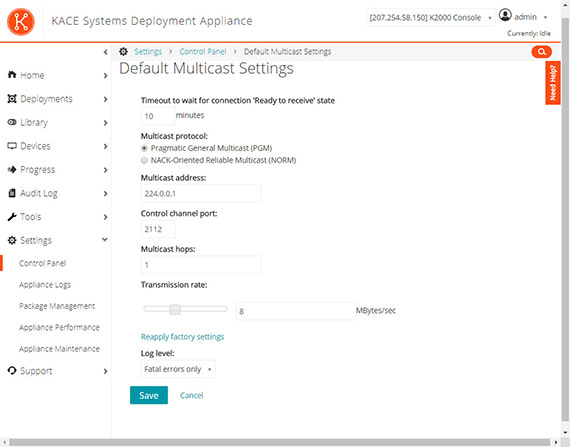System Deployment with Multicasting
Streamline your large-scale systems imaging projects with the powerful multicast imaging software capabilities of the KACE Systems Deployment Appliance (SDA). You’ll save time, improve speed to deployment and lighten the load on your network resources and bandwidth with multicasting.

How it works:
Multicasting
Multicasting supports one-to-many data transmission across the network, rather than creating multiple one-to-one connections to each system. Through the process of multicasting, the communication and processing overhead of sending the same data packet or data frame is minimized. The destination nodes send join and leave messages that inform the routers of whether they are correct recipients of the messages. The KACE SDA multicast imaging software sends the data packet only once, irrespective of the number of users. The KACE SDA multicast imaging software then performs necessary replications so that the packet can reach multiple receivers simultaneously.
Quickly and efficiently deploy the same image simultaneously to multiple systems and improve imaging performance with the KACE SDA multicast imaging software. Ensure the reliability and robustness of your multicasting deployment with two-way communication between target devices on your broadcast network and the KACE SDA server. Gain confidence that your deployments stay on track with frequent status updates and rebroadcast requests.
Reduced bandwidth consumption
Multicasting allows you to send a single image over your network once to multiple targeted destination systems. Using the KACE SDA multicast imaging software greatly reduces the amount of bandwidth consumed by large-scale deployments. A number of factors determine deployment speed, such as the size of your image and the number of systems involved. Combine multicasting system deployment capabilities with the KACE SDA's powerful task engine to enable true hands-off and lights-off system imaging to further reduce bandwidth consumption and improve network performance during work hours.
In unicast, one station transfers the information to only one receiver station. In multicast, the sender transfers the information to a group of interested receiver stations. The fundamental difference between unicast and multicast is that unicast is one-to-one communication and multicast is a one-to-many communication process.
Unicasting, multicasting and broadcasting all have differing degrees of message delivery. In the multicast case, devices effectively subscribe to receive messages. In the broadcast case, however, devices receive messages regardless of whether or not they want to. In the unicast case, the device is the only one receiving that message. With the KACE SDA systems imaging solution, you can easily select the deployment method that fits your situational need.
Send a single image over your network once to multiple systems using the KACE SDA and greatly reduce the amount of bandwidth consumed by large-scale deployments, depending on the size of your image and the number of systems involved. Combine multisystem deployment capabilities with the KACE SDA’s powerful task engine to enable true lights-off software distribution to further reduce bandwidth consumption and improve network performance during work hours.
